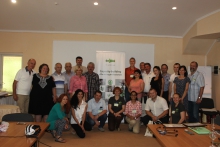
“Ultimately, our success at the Forest Service will be measured in terms of watershed health on those 193 million acres of national forests and grasslands.”
Tom Tidwell, Chief, Forest Service, April 29, 2010
We would like to draw conclusions of the training “Application of watershed classification in Carpathian Ukrainians”, which took place during July 23-27 in Pynya river watershed (Polyana community of Svalava district, Zakarpattya). The training was thoroughly prepared by FORZA NGO together with USFS International Programmes in frame of the project “Skilled foresters = Better forests”, financed by the US Forest Service.
For this training USFS IP engaged best experts on issues, related to watershed assessment, with long-term experience on the methodology and practical application of watershed condition classification (WCC). The training was led by USFS experts Mike Owen, Sheela Johnson, and Raha Hakimdavar, and Raha also presented geo-information systems and remote sensing tools (GIS and RS). We should also mentioned hard backstage work of Ted Geier, one of the authors of watershed condition classification, who last year delivered introductory seminar on watershed condition framework (WCF) and WCC to the professionals in Ukraine and currently helped USFS experts in preparation to this mission.
Managers and trainers have set up rather ambitious tasks – during five days of training, based on the methodology of US Forest Service:
(І) understand and anchor in practical exercises the process of watershed condition classification by each of its 12 indicators;
(ІІ) to learn to conduct collection of data on the attributes of the watershed condition indicators, including the preliminary collected information;
(ІІІ) identify gaps in data and information, needed for assessment of watershed condition class;
(iv) jointly conduct watershed condition assessment of Pynya river watershed based on all information, received and processed as of the end of the training;
(v) jointly identify, whether it is possible and under what conditions, to use this approach in the management practice of forest managers and land managers at the territory of Ukrainian Carpathians;
(vi) if possible, identify the actions and activities which should be taken for the anchoring of this approach in daily practices of land and natural resource managers in Ukrainian Carpathians.
The training attracted active participation of professionals in fields of forestry, hydrology, water biology, forest road construction, ecology etc. from different levels and institutions of local resource management, academia, and public administration, namely: Institute of Hydrobiology of the National Academy of Sciences of Ukraine, Ministry of environment and natural resources of Ukraine, National agency of forest resources of Ukraine, Ukrainian scientific and research institute of mountain forestry and its regional affiliate, National Forest Technical University, Prykarpattya National University, Uzhhorod National University, Lviv forest inventory expedition, Ukrainian office of WWF Danube-Carpathian Program, Tysa River Basin Management Agency, Zakarpattya regional department of environment and natural resources, Zakarpattya affiliate of National soil protection service, Zakarpattya regional ecological inspection, Zakarpattya hydro-meteorological center, SE “Svalyava state forest enterprise”.
Training was held in format 50% theory / 50% practice, due to which all participants had the possibility to receive rather detailed information on the watershed condition classification by each of its 12 indicators and respective attributes, as well as learn certain methods of assessment of watershed elements during practical field sessions. This practical component of the training many participants distinguished as an interesting and effective approach to getting new knowledge and skills.
At the end of the week-long training all participants in small groups had the possibility to assess condition of certain indicator by each of its attribute and in justified manner provide own conclusions regarding indicator condition class. Later all scores of experts were summed up (using WCC calculator) to the watershed condition general score, which formed Class 2 of the concerned watershed condition, which means “Functioning at risk” due to exhibited moderate geomorphic, hydrologic, and biotic integrity relative to their natural potential condition.
During the training week there were many discussions related to the correspondence of USFS WCC and EU Water Framework Directive, as well as other issues, such as: how to define watersheds and assess its conditions within the Ukrainian normative documents requirements, how to ensure cooperation among different agencies in issue of integrated natural resource planning and management (land management of forest and agricultural resources, water resources, material resources, biodiversity etc.), within common watersheds, what documents should be elaborated and signed in order to apply concerned approach in practice. Many questions were left without clear answer – leaving wide space for inter-disciplinary and inter-agency cooperation in Ukraine.
We hope, this training will in fact become the first concrete step in introduction of watershed condition classification in Ukrainian Carpathians, and will inspire stakeholders to improve own knowledge and skills and normative base for the provision of proper condition of mountain watersheds.
For this reason, our organization will compile information, gained during preparation and conduction of this training, and will disseminate it among all stakeholders, involved in issues of sustainable natural resources management in order to jointly develop optimal system of mountain watersheds management.
Photo reports at the below links:
https://photos.app.goo.gl/X8mKimY4CApqMBacA (Yuriy Derbal’ pictures)
https://photos.app.goo.gl/fPJejtYHyC1G8GzA9 (FORZA camera)
Presentations (Eng versions) from the training below:
Day 1:
Day 2:
Day 3:
Day 4:
Day 5:



